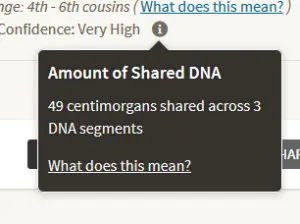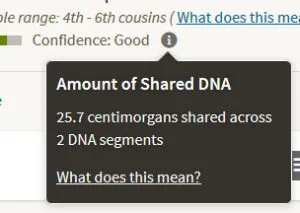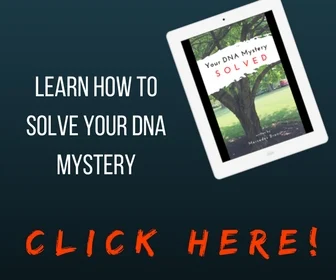If you are like most people, you probably have a list of DNA matches that contains thousands of people. The relationships of these "cousins" to you can range from a close relationship, like a first cousin, to an 8th cousin once-removed - or even more distant! Sometimes, the relationship can even be more distant. I, for example, have approximately 14,500 DNA matches on my list.
What in the world could I gain from contacting these people who are, literally, both family and stranger?
Should You Contact These DNA Matches?
I would like to give you some food for thought as you scroll through your list and decide whether you will contact some of your matches. Depending on how many people you have on your list, you will probably not be able to ever get in touch with all of them. That said, you might find some surprises and learn some great family history if you do get in touch with a few.
In my own personal experience, I have had a very positive experience contacting my DNA relatives. I have never had anyone be rude to me. At the very worst, I have just received a polite note stating that they wish they could be more helpful, but that they don't know much about their family's history.
Your Close DNA Matches are Just That - CLOSE
We are going to call "close" matches anyone who matches you at a 3rd cousin or closer level. These family members are the children, grandchildren, great-grandchildren and the great-great grandchildren of your most recent ancestors.
By contacting these family members - and basically putting the pieces of your family puzzle "back together", if you will - you may be able to construct a very through narrative of those generations further back. There may be documents, photographs, and even family artifacts that your family members can share with you. And you may be able to share information with them and help them solve mysteries, too.
Just recently, I was able to speak personally with my deceased grandmother's first cousin. This man, who is now 80, is a first cousin twice-removed to me. He shared many memories with me, such as when he lived with his grandfather (my great-great grandfather!), our German immigrant ancestor on that line. It was amazing to be able to hear a personal account of the type of person that my great-great grandfather was, instead of always counting on census records and other documents.
Your "Distant" Match Might Actually Be More Closely Related Than You Think
Just because a person is listed on your distant match list on Ancestry doesn't mean that they are really a distant cousin. I like to use the definition of a distant cousin as a 4th cousin or further. I have numerous people on my distant cousin list who are actually much more closely related to me. In fact, my mother had a known second cousin show up on her distant cousin match list.
There are several reasons why this can happen:
- In the case of my mother's known second cousin, they shared only ONE great-grandparent. This second cousin and my mother share a great-grandfather, but do not share a great-grandmother. This ancestor had remarried after the death of his first wife, and had my mom's grandfather. This means that my mother and her cousin only share 50% of the DNA that they would typically share.
In the image below, you can see how much DNA I share with my half 2nd cousin once-removed, yet Ancestry predicted our relationship to be in the 4th-6th cousin range:

I'm so glad that I already knew about this relative, other wise I might have just kept on scrolling on my DNA list and never thought to contact him. He has been, by far, a great partner in family tree research.
Do you want to know how to see how much DNA you share with your matches on Ancestry DNA? I wrote a post about it - just for you.
(And as a note, he doesn't even show up on my daughter's DNA match list. He and my daughter are 2nd cousins twice-removed, and their relationship could have easily been lost to obscurity if we hadn't contacted each other.)
- A second reason that your "distant" matches might not be so distant is because we don't always inherit DNA in even percentages every generation. Sometimes - simply by the luck of the draw - we might share at the bottom of the range that we can share with a particular relative - and our offspring will have a much smaller amount of matching DNA with that relative than they would have.
For example, I have a match on my DNA list who is my 3rd cousin once-removed. The only reason I noticed her is because she still has a surname that has been passed down from my great-great-great grandparents (through an all male line stopping at her). She shares a small amount of DNA with my mother and absolutely NO DNA with my mother's two full siblings.
In the image below, you can see how much DNA she shares with me - a very small amount! Ancestry predicts our relationship to be between 4th-6th cousins, when in reality we are 3rd cousins once-removed.

After I contacted her, we were quickly able to figure out how we are related and are in the process of sharing information and understanding the trajectory of that line of our Slovak family in the United States. How cool is that?
But What if They Don't Have a Tree?
I can easily talk myself out of contacting my DNA matches if they don't have a family tree on Ancestry. That said, many times they actually DO have a family tree, but they haven't bothered to upload it to the website yet. If you find a match that is on a family line that you would really like to learn more about, you should always take a few minutes to send a note.
You never know what you'll learn. And at worst, you'll meet a new family member 🙂
On that note, do YOU have a tree?
While we are discussing whether or not your matches have a family tree, it's a good time to check to see if you have built one for your own family? Building a family tree makes it much easier to figure out how your matches are related to you.
I recommend building a tree and including links to it on all of your DNA testing profiles, including Gedmatch Genesis. If you haven't yet started building a tree, I recommend Ancestry. It's free and easy to build as many trees as you want.
While it's free to build your tree on Ancestry, you might want access to records and documents (including photographs uploaded by other Ancestry users) pertaining to your ancestors, and for that you need a subscription.
Conclusion
You can probably tell that I very enthusiastically recommend that you send a polite note, including as much information as you feel is appropriate to include, to many of your DNA matches. It's the best way to build your family tree and learn as much as you can about the human side of your family story.
Further reading on the topic of contacting matches:
- How to contact DNA matches
- Six reasons you should contact DNA matches
- Why DNA matches don't respond
- How to increase responses from DNA matches
Have you ever contacted any of your matches? Have you learned anything interesting? I'd love to hear from you in the comments.
Thanks for stopping by!

